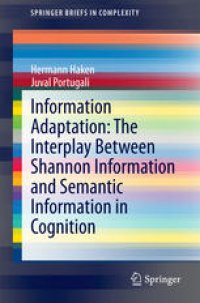
Ebook: Information Adaptation: The Interplay Between Shannon Information and Semantic Information in Cognition
- Tags: Complexity, Socio- and Econophysics Population and Evolutionary Models, Computational Intelligence, Nonlinear Dynamics
- Series: SpringerBriefs in Complexity
- Year: 2015
- Publisher: Springer International Publishing
- Edition: 1
- Language: English
- pdf
This monograph demonstrates the interplay between Shannon information and semantic information in cognition. It shows that Shannon’s information acts as driving force for the formation of semantic information; and vice versa, namely, that semantic information participates in the formation of Shannonian information. The authors show that in cognition, Shannonian and semantic information are interrelated as two aspects of a cognitive process termed as information adaptation. In the latter the mind/brain adapts to the environment by the deflating and/or inflating of the information conveyed by the environment. In the process of information adaptation, quantitative variations in Shannon’s information entail different meanings while different meanings affect the quantity of information. The book illustrates the above conceptually and mathematically by reference to three cognitive processes: pattern recognition, face learning and the recognition of a moving object.
This monograph demonstrates the interplay between Shannon information and semantic information in cognition. It shows that Shannon’s information acts as driving force for the formation of semantic information; and vice versa, namely, that semantic information participates in the formation of Shannonian information. The authors show that in cognition, Shannonian and semantic information are interrelated as two aspects of a cognitive process termed as information adaptation. In the latter the mind/brain adapts to the environment by the deflating and/or inflating of the information conveyed by the environment. In the process of information adaptation, quantitative variations in Shannon’s information entail different meanings while different meanings affect the quantity of information. The book illustrates the above conceptually and mathematically by reference to three cognitive processes: pattern recognition, face learning and the recognition of a moving object.